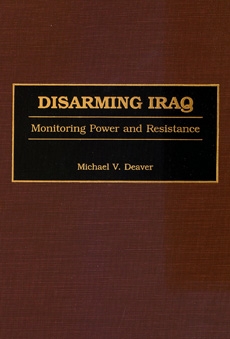| Éditeur : Library of Congress | Date & Lieu : 2001-01-01, America |
| Préface : | Pages : 152 |
| Traduction : | ISBN : 0-275-97261-5 |
| Langue : Anglais | Format : 155x235 mm |
| Code FIKP : Liv. Ang. 1912 | Thème : Politique |
|
Présentation
|
Table des Matières | Introduction | Identité | ||
 Disarming Iraq, monitoring power and resistance Michael V. Deaver is Visiting Lecturer and Academic Coordinator of the Civic Education Project in Russia. He has traveled extensively in the Middle East and has taught courses on international relations and comparative politics in Russia as a Civic Education Project fellow for three years. | |||||
|
Abbreviations ACDA United States Arms Control and Disarmament Agency APC armored personnel carrier BMVC Baghdad Monitoring and Verification Center EMIS Electromagnetic Isotope Separation GPS global positioning system HUMINT human intelligence IAEA International Atomic Energy Agency MINT imagery intelligence IMT Interim Monitoring Team MTCR Missile Technology Control Regime NPT Nuclear Nonproliferation Treaty OMV ongoing monitoring and verification OSI on-site inspection SCR Security Council resolution Scud a type of Soviet-made ballistic missile SIGINT signals intelligence SIPRI Stockholm International Peace and Research Institute Stage 1 information gathering and assessment Stage 2 disposal of proscribed items Stage 3 ongoing monitoring and verification UNIDIR United Nations Institute for Disarmament Research UNIKOM United Nations Iraq-Kuwait Observation Mission UNMOVIC United Nations Monitoring, Verification and Inspection Commission UNSCOM United Nations Special Commission WMD weapons of mass destruction 1 Introduction The flickering image of a boiler-like machine on a television screen at a United Nations office here [Baghdad] indicates that the monitoring system imposed on Iraqi industry four years ago [1991] is achieving its aim of preventing President Saddam Hussein from building weapons of mass destruction.... A little green line, constantly expanding and contracting at the bottom of the screen at the United Nations office, means the picture is being relayed live from a camera trained on an instrument known as a vacuum furnace on a factory floor somewhere in Iraq.1 Last month [December 1997], the United Nations weapons inspectors thought they were closing in on a long-sought prize: computer hard disks that contain the records of Iraq's entire program of weapons of mass destruction.... But the Iraqis stalled for 20 minutes, as inspectors watched from a distance while the old hard drives were whisked away and replaced with new ones. When the inspectors finally got permission to enter, the equipment ran only computer games.2 The international reaction to the Iraqi invasion and occupation of Kuwait in August 1990 resulted in numerous binding and increasingly demanding Security Council decisions, which were implemented with vigor. Besides bringing a formal end tothe Second Gulf War (1990-1991), resolution 687 also placed a broad array of obligations upon the Iraqi government. The central aspect of this historic resolution was an ambitious set of disarmament requirements supported by provisions for intrusive implementation that were unprecedented for the United Nations (UN). Although the Security Council established a strong power relationship over Iraq to ensure the elimination of Iraq's unconventional weapons and monitoring of their means of production, the government energetically resisted. The power struggle between Iraq and the UN over implementation of these disarmament obligations came to dominate Iraq's relations with the rest of the international community and they long remained a major issue in world politics.
| ||||